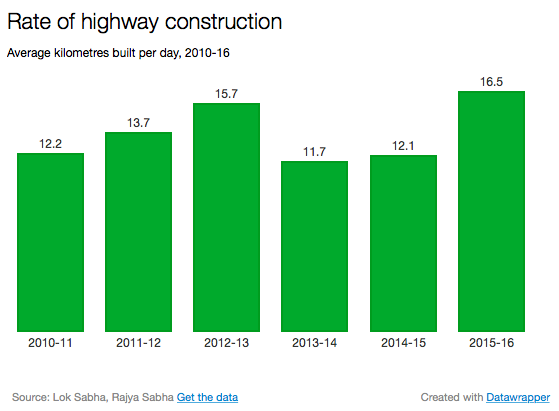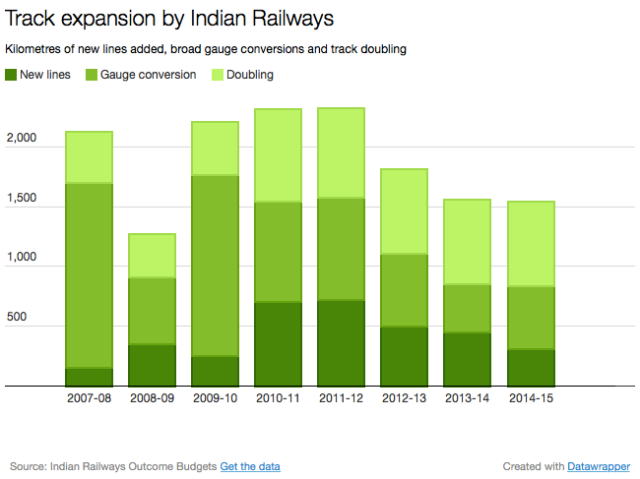There’s something about serving in the Modi government that converts seemingly sensible people into inept spinmeisters. Consider the respected Columbia University economist and NITI Aayog Vice Chairman Arvind Panagariya. In an 8 May 2016 Business Standard op-ed titled The turnaround in infrastructure, he reeled off the Modi government’s many accomplishments in this arena. Following which he warned critics to “ponder the fate of infrastructure in the country had the previous administration continued.”
Except, if anybody bothers to look closer, Panagariya’s claims turn out to be irrelevant, misleading or simply false. In fact the “previous administration” equalled or exceeded many of the Modi government’s infrastructure achievements.
Consider highway construction. Panagariya points out that the government has unblocked Rs 3.5 lakh crore out of Rs 3.8 lakh crore worth of stuck road projects, and that “the construction (sic) of national highway projects awarded has risen from 3,500 kilometres in 2013-14 to 8,000 kilometres in 2014-15 and 10,000 kilometres in 2015-16.” So far so good.
But then he proudly adds:
“Road construction has risen from 8.5 kilometres a day during the last two years of the previous government to 11.9 kilometres in 2014-15 and 16.5 kilometres in 2015-16.”
A near doubling of the highway construction rate, pretty impressive right?
Not even close. Real data show that, in its last two years, the United Progressive Alliance (UPA) built 13.7 km/day of highways, compared with 14.3 km/day built in the first two years of the Modi government. That’s pretty much the same pace. In Panagariya’s defence, his fibs aren’t as blatant as Roads Minister Nitin Gadkari’s ravings (see Nitin Gadkari’s highway jumla), but they’re still way off.
As the chart below shows, there is no need to lie. The UPA did well, and in 2015-16 the Modi government did a bit better.

Let’s look at railways next. Panagariya claims that:
In railways, the average rate of expansion of tracks has risen to 7 kilometres per day during 2015-16 from 4.3 kilometres per day during the previous six years. Investment in railways during 2015-16 has been double the average during the preceding five years.
An impressive increase, at least at first glance. But hold on. Panagariya is conflating track expansion with track commissioning. This detail is taken from Rail Minister Suresh Prabhu’s 25 Feb 2016 budget speech, in which Prabhu changed the measure of rail expansion from “completion” to “commissioning” because “nothing has started functioning until it has been commissioned”.
Fair enough. But, just out of curiosity, what does the old “track completion” metric, used for so many years, show?

Say it ain’t so! What the Modi government claims to be a six-year track expansion high under this convenient new metric turns out to be a six-year low according to the now-discarded metric. Could the policy paralysed, rudderless UPA really have built tracks faster than the 56-inch Modi Sarkar? We’re still waiting to hear whether the government has hit its more ambitious 2,500 km target for 2015-16 (according to the old measure), but keep in mind that even this just about tops the UPA’s 2,300 km plus record in 2010-11 and 2011-12.
What about the claim that the Railways’ investment in 2015-16 was “double the average during the preceding five years”? A former Railways official points out in a 10 May 2016 Indian Express article that the Rs 94,000 crore railway investment figure for 2015-16 includes Rs 15,081 crore in funding for joint venture partners, a category not previously included. A like for like comparison shows the Railways’ investment to amount to Rs 70,000 crore in 2015-16, a record number but nowhere close to double the previous five-year average of Rs 48,000 crore. Busted.
(This propensity to spin isn’t new, as Manoj K noticed in Railway Ministry: 8 Achievements That Really Aren’t in July 2015.)
There are other claims in Panagariya’s op-ed, including some that may be true. Consider:
In domestic civil aviation, the total number of passengers carried has jumped from 66.4 million in 2014 to 80.8 million in 2015.
Great, but this had almost nothing to do with government policy.
In power, the government has already electrified 6,816 villages in the last two years compared with 5,189 villages in the three years before that. The prime minister has now announced his intention to bring electricity to the 12,000 villages or so that are yet to be electrified, by May 1, 2018.
A good effort, no doubt, but still modest once we look at a longer period. Turns out that rural electrification under the UPA in 2006-07, for instance, proceeded at four times the NDA’s rate. Cherrypick much?
Furthermore an investigation by The Hindu‘s Samarth Bansal shows even this 7,000 number to be exaggerated, and “that unelectrified villages have been counted as electrified”. To be fair the UPA’s numbers could be considered similarly suspect, but the fact is that the UPA vastly outperformed the Modi government in this arena.
One could go on, but it seems clear that Panagariya, like so many others in the Modi government, is guilty of cherry-picking or distorting data to make the government’s case. Not only is this futile, it obscures and even undermines the government’s genuine achievements. But in the interpretive dance that is the Modi Sarkar, facts don’t seem to count for much.

Why any of the charts are not clickable? No citing of data sources that can be cross verified? I suspect this is a hit-job… On railways, if you subtract 15000 cr from 94000 cr, how come the revised no. is 70000 cr? Shouldnt it be 79000 cr?
The charts are not clickable because WordPress.com does not permit Datawrapper charts to be embedded. However the sources are mentioned in the charts.
As for the Rs 70,000 cr figure, it is taken directly from the Indian Express article.
Did you run off with your hit-job conspiracy theory after the sources were mentioned ?
What conspiracy theory?
Can’t find the data for Highways constructed in the source mentioned. Please forward.
Ministry of Road Transport and Highways, Annual Report 2015-16, p.19.
Hi Sir.
Very interesting piece.
Where did you get the village electrification numbers from?
Data from http://www.cea.gov.in gives a completely different set of numbers. Like in 2011-2012, 9835 villages were electrified. In 2013-2014, 10,562. This is very different from your data.
Please help me with this.
Thanks
Vivek ,
Ministry of Power, Annual Report 2013-14, p. 41.
Thank you…The data at different places is totally different…Thanks for this…
It would be great if you provide links (maybe with page numbers) to all the sources mentioned.. Just googling the source name alone does not take us to the proper report that states the figures.. You could atleast provide the sources in the end as a ‘references’ section, as found in academic articles..
Fact-finding sites like IndiaSpend & Factly.in provide bullet proof sources which are usually authentic govt departmental reports hosted on government servers..
Links with page numbers regarding roads and rural electrification are provide above.
Rail numbers are in the Outcome Budgets available on the Ministry of Railways website. Look at the 2016-17 outcome budget, p.11 and the 2013-14 outcome budget, p.12.
Pingback: Why is Arvind Panagariya Cherry Picking Data to Show Modi Govt in Good Light? | Easy Money
lotus flowers bloom profusely in murky waters.
why do you wonder then that the current party in power and its acolytes are creating an appropriate environment within the country?
Cherry picking in statistics is nothing new. Every govt uses that. But i think if Modi govt gives credit to UPA when due would improve its image that they are all together when it comes to improving infrastructure of India.